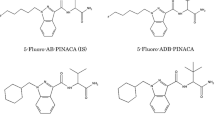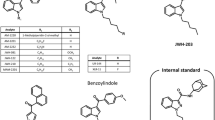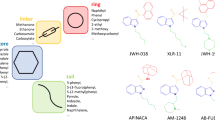Abstract
“Herbal highs” are a group of products marketed in recent years as legal substitutes for marijuana. This article presents the results of examinations performed on samples seized in “head shops” and from individuals during a 3.5-year period, between mid-2008 and the end of 2011 in Poland. Of over 2000 samples delivered for analysis, 420 preparations were selected for this study. Gas chromatography–mass spectrometry and liquid chromatography–quadrupole-time-of-flight–mass spectrometry were used for identification of psychoactive components, and high-performance liquid chromatography was used for their quantitation. The most common ingredients of herbal highs were: JWH-081 (144 products), JWH-018 (103), RCS-4 (92), JWH-073 (89), JWH-250 (75), JWH-122 (69), cannabicyclohexanol (55), and JWH-210 (38). Over 50 % of the products contained two or more active ingredients; 136 products (32.4 %) contained two; 56 products (13.3 %) contained three; and 22 (5.2 %) contained more than three. Common combinations of ingredients were investigated by the graph method; substances coexisted mainly with those introduced into the drug market in a similar period of time. The most common dual combinations were JWH-081 + RCS-4 (18 products), JWH-073 + JWH-250 (16), and JWH-081 + JWH-250 (12). JWH-081 was blended with almost all detected synthetic cannabinoids. The main risks of the use of these substances were due to ignorance of great variation in the content and composition of synthetic cannabinoids even if the products had identical labels. This inconsistency could cause serious health damage to users, while ignorance of the fact that more than one third of the products being sold at head shops contain illicit compound(s) could result in unexpected arrest.




Similar content being viewed by others
References
Synthetic marijuana on the rise: looks like pot, but ‘far worse’. http://news.yahoo.com/synthetic-marijuana-rise-looks-pot-far-worse-224953961.html. Accessed Apr 2012
Auwärter V, Dresen S, Weinmann W, Müller M, Pütz M, Ferreiros N (2009) ‘Spice’ and other herbal blends: harmless incense or cannabinoid designer drugs? J Mass Spectrom 44:832–837
Johnson LA, Johnson RL, Alfonzo C (2011) Spice: a legal marijuana equivalent. Mil Med 176:718–720
Uchiyama N, Kikura-Hanajiri R, Kawahara N, Haishima Y, Goda Y (2009) Identification of a cannabinoid analog as a new type of designer drug in a herbal product. Chem Pharm Bull 57:439–441
Lindigkeit R, Boehme A, Eiserloh I, Luebbecke M, Wiggermann M, Ernst L, Beuerle T (2009) Spice: a never ending story? Forensic Sci Int 191:58–63
Zuba D, Byrska B, Maciow M (2011) Comparison of “herbal highs” composition. Anal Bioanal Chem 400:119–126
ACMD (2009) Consideration of the major cannabinoid agonists. http://www.homeoffice.gov.uk/publications/drugs/acmd1/acmdreport-agonists?view=Binary. Accessed May 2012
Zuba D, Byrska B, Pytka P, Sekuła K, Stanaszek R (2011) Widma masowe składników aktywnych preparatów typu dopalacze (Mass spectra of active ingredients of ‘legal high’ products). Institute of Forensic Research Press, Kraków
Sekuła K, Zuba D, Stanaszek R (2012) Identification of naphthoylindoles acting on cannabinoid receptors based on their fragmentation patterns under ESI-QTOFMS. J Mass Spectrom 47:632–643
Uchiyama N, Kawamura M, Kikura-Hanajiri R, Goda Y (2011) Identification and quantitation of two cannabimimetic phenylacetylindoles JWH-251 and JWH-250, and four cannabimimetic naphthoylindoles JWH-081, JWH-015, JWH-200 and JWH-073 as designer drugs in illegal products. Forensic Toxicol 29:25–37
Nakajima J, Takahashi M, Seto T, Suzuki J (2011) Identification and quantitation of cannabimimetic compound JWH-250 as an adulterant in products obtained via the Internet. Forensic Toxicol 29:51–55
Nakajima J, Takahashi M, Seto T, Kanai C, Suzuki J, Yoshida M, Hamano T (2011) Identification and quantitation of two benzoylindoles AM-694 and (4-methoxyphenyl)(1-pentyl-1H-indol-3-yl)methanone, and three cannabimimetic naphthoylindoles JWH-210, JWH-122, and JWH-019 as adulterants in illegal products obtained via the Internet. Forensic Toxicol 29:95–110
Nakajima J, Takahashi M, Seto T, Kanai C, Suzuki J, Yoshida M, Hamano T (2011) Identification and quantitation of a benzoylindole (2-methoxyphenyl)(1-pentyl-1H-indol-3-yl)methanone and a naphthoylindole 1-(5-fluoropentyl-1H-indol-3-yl)-(naphthalene-1-yl)methanone (AM-2201) found in illegal products obtained via the Internet and their cannabimimetic effects evaluated by in vitro [35S]GTPγS binding assays. Forensic Toxicol 29:132–141
Nakajima J, Takahashi M, Seto T, Yoshida M, Kanai C, Suzuki J, Hamano T (2012) Identification and quantitation of two new naphthoylindole drugs-of-abuse, (1-(5-hydroxypentyl)-1H-indol-3-yl)(naphthalen-1-yl)methanone (AM-2202) and (1-(4-pentenyl)-1H-indol-3-yl)(naphthalen-1-yl)methanone, with other synthetic cannabinoids in unregulated “herbal” products circulated in the Tokyo area. Forensic Toxicol 30:33–44
Uchiyama N, Kawamura M, Kikura-Hanajiri R, Goda Y (2012) Identification of two new-type synthetic cannabinoids, N-(1-adamantyl)-1-pentyl-1H-indole-3-carboxamide (APICA) and N-(1-adamantyl)-1-pentyl-1H-indazole-3-carboxamide (APINACA), and detection of five synthetic cannabinoids, AM-1220, AM-2233, AM-1241, CB-13 (CRA-13), and AM-1248, as designer drugs in illegal products. Forensic Toxicol 30:114–125
Link system. http://link.iisg.agh.edu.pl. Accessed May 2012
Dębski R, Kisiel-Dorohinicki M, Miłoś T, Piętak K (2010) LINK—a decision-support system for criminal analysis. In: Proceedings of MCSS: multimedia communications, services and security: IEEE international conference, Kraków, 6–7 May 2010
Terrettaz-Zufferey A, Ratle F, Ribaux O, Esseiva P, Kanejski M (2007) Pattern detection in forensic case data using graph theory: application to heroin cutting agents. Forensic Sci Int 167:242–246
Huffman JW (2009) Cannabimimetic indoles, pyrroles, and indenes: structure–activity relationships and receptor interactions. In: Reggio PH (ed) The cannabinoid receptors. Humana Press, New York, pp 49–94
Huffman JW, Zengin G, Wu MJ, Lu J, Hynd G, Bushell K, Thompson ALS, Bushell S, Tartal C, Hurst DP, Reggio PH, Selley DE, Cassidy MP, Wiley JL, Martin BR (2005) Structure–activity relationships for 1-alkyl-3-(1-naphthoyl)indoles at the cannabinoid CB1 and CB2 receptors: steric and electronic effects of naphthoyl substituents. New highly selective CB2 receptor agonists. Bioorg Med Chem 13:89–112
Huffman JW, Padgett LW (2005) Recent developments in the medicinal chemistry of cannabimimetic indoles, pyrroles and indenes. Curr Med Chem 12:1395–1411
Huffman JW, Szklennik PV, Almond A, Bushell K, Selley DE, He H, Cassidy MP, Wiley JL, Martin BR (2005) 1-Pentyl-3-phenylacetylindoles, a new class of cannabimimetic indoles. Bioorg Med Chem Lett 15:4110–4113
Fruchterman TMJ, Reingold EM (1991) Graph drawing by force-directed placement. Softw Pract Exp 21:1129–1164
Zuba D, Byrska B (2012) Prevalence and co-existence of active components of “legal highs”. Drug Test Anal. doi:10.1002/dta.1365
Kneisel S, Bisel P, Brecht V, Broecker S, Müller M, Auswärter V (2012) Identification of the cannabimimetic AM-1220 and its azepane isomer (N-methylazepan-3-yl)-3-(1-naphthoyl)indole in a research chemical and several herbal mixtures. Forensic Toxicol 30:126–134
Author information
Authors and Affiliations
Corresponding author
Additional information
This article is for the special issue TIAFT 2012 edited by Osamu Suzuki.
Rights and permissions
About this article
Cite this article
Zuba, D., Byrska, B. Analysis of the prevalence and coexistence of synthetic cannabinoids in “herbal high” products in Poland. Forensic Toxicol 31, 21–30 (2013). https://doi.org/10.1007/s11419-012-0159-0
Received:
Accepted:
Published:
Issue Date:
DOI: https://doi.org/10.1007/s11419-012-0159-0




